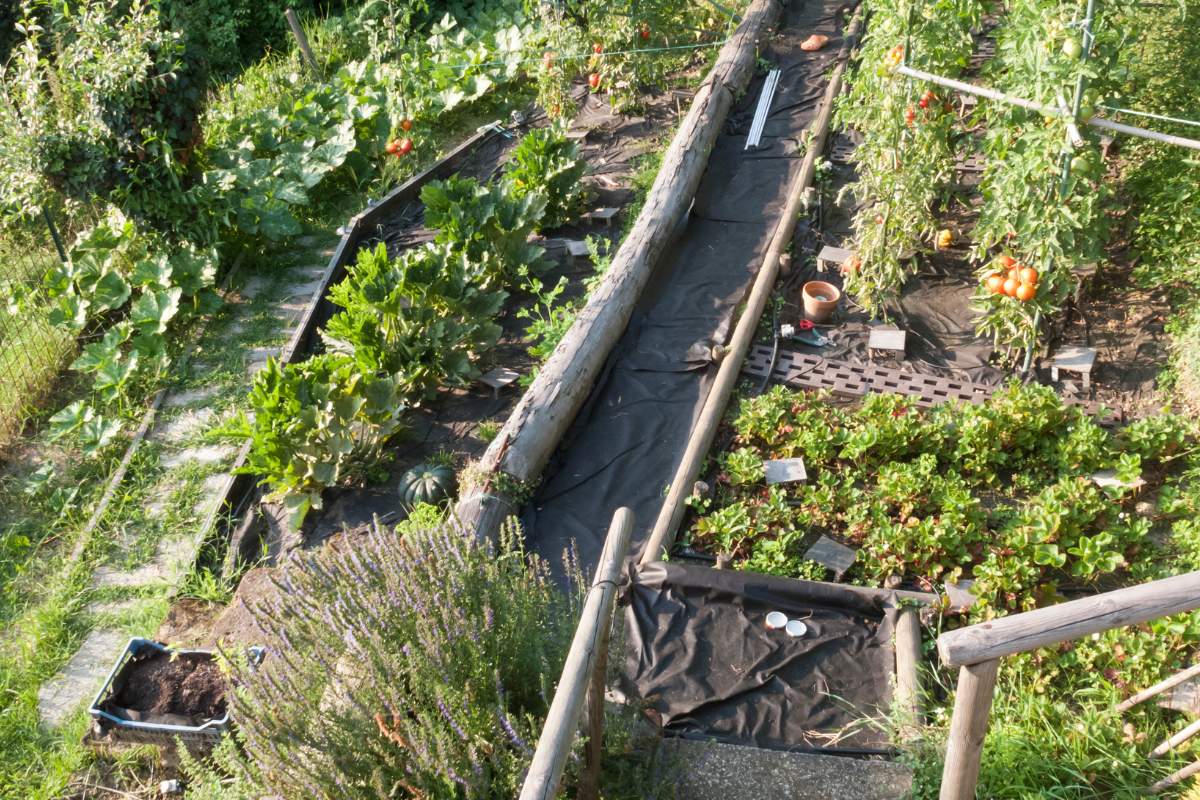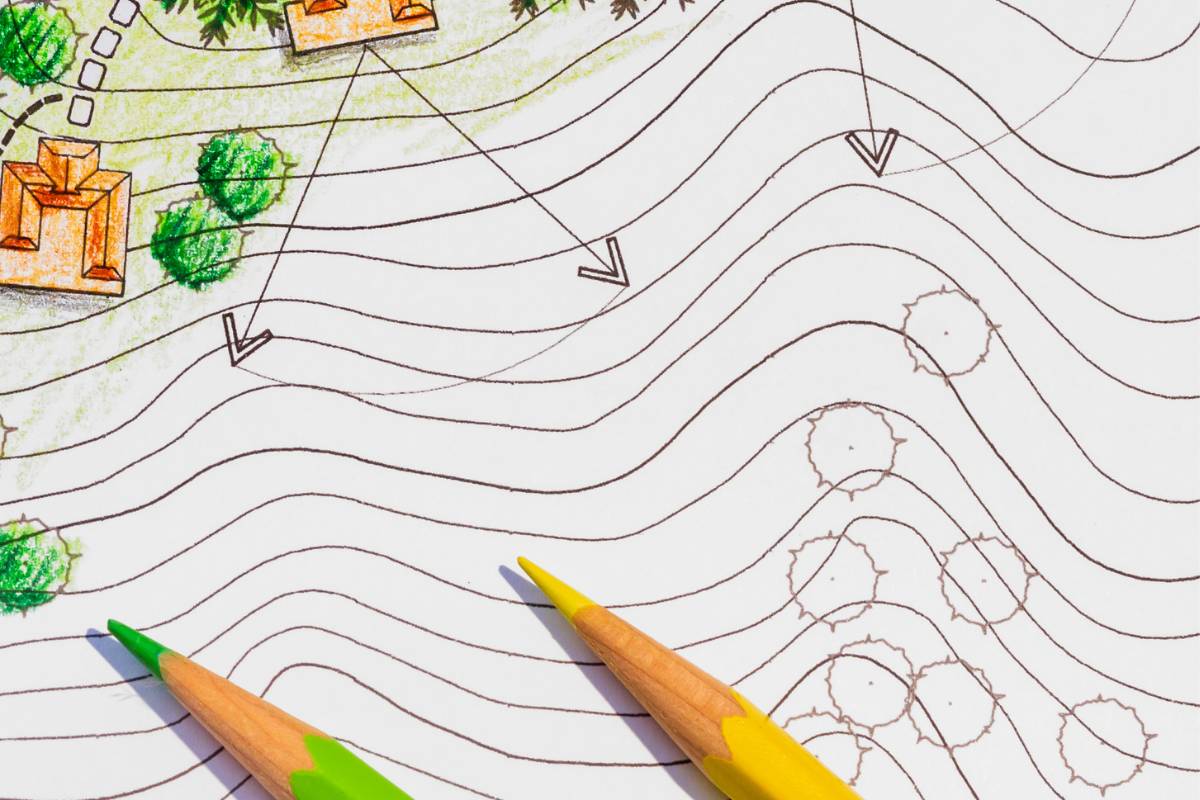Sloped blocks are incredibly picturesque and offer many unique opportunities for the avid gardener. But gardening on a slope doesn’t have to be an uphill battle. Implementing a few simple techniques can make your garden beautiful and productive.
Let’s learn how to transform your rolling landscape into a fruitful vegetable garden.
What Is a Sloped Block?
A sloped block is a plot of land with uneven elevation. It isn’t flat like “standard” parcels of land; instead, the ground slopes from one end of the property to the other.
While some see a sloped garden as a liability, there are many benefits to growing vegetables on a slope, including:
- Unique landscape opportunities: Sloped blocks allow multiple levels, rock walls, terracing, aesthetic stairways, and more.
- Natural drainage: Sloped gardens can be very beneficial during the rainy season as the water flows downhill.
- Sun exposure: North-facing gardens take advantage of more direct sunlight, while south-facing slopes are perfect for shade gardens.
- Warmth for your plants: Slopes create a warm microclimate from the more direct sunlight, or the heat generated and trapped by terracing or retaining walls.
- More garden space: A sloped garden will have more surface area than a flat garden of the same size.
- Avoid mowing: Turning your sloped block into a vegetable garden means you won’t have to mow up and down the hill.
Planning a Vegetable Garden on a Slope
Before you get started planning your garden, it is important to take in the lay of the land. This will help you plan what sort of landscaping your garden will require, and the best position for your plants.
Start planning your sloped block garden by doing the following:
1. Evaluate the Slope
First, determine if your property is on an incline (sloping upwards from the property line), a decline (sloping down), or if it slopes sideways.
You also want to know the grade, or how steep the slope is. While definitions vary by region, most builders agree that a slight grade is less than 10%, a steep grade is 20% or more, and everything in between is considered moderate.
Shallow slopes are much easier (and cheaper) to work with, but with proper planning, even a steep grade can be turned into a functional and productive garden.
2. Consider Drainage and Erosion
To reduce erosion, prevent terrace walls cracking, soil sifting, and runoff pooling at the bottom of the slope, terrace walls often need drainage spots installed.
As water runs down your sloped garden, it washes soil and nutrients with it. so make an effort to prevent erosion and runoff, especially if you live in a climate with heavy rainfall. Terracing, permanent plantings, mulch, and landscape fabric are all great ways to hold the soil in place and slow the flow of nutrient-laden water.
It is also important to consider the direction of the water flow. You don’t want water to pool where it will ruin foundations, run into a house or building, or cause other problems. Redirecting the water or installing good drains might be necessary to prevent water damage.
In hot weather, soil at the top of your garden will dry out faster than soil near the bottom of the slope. Make sure you have a watering system (such as drip irrigation) or plant drought-tolerant plants at the top.
3. Soil Type
Soil type is important to any garden but is extra important on a sloped block. Sand and silt soils drain faster and are more prone to erosion. On the flip side, clay soil becomes slick in wet weather, and hard and unworkable hard in the heat and when it’s dry.
Due to the constant erosion and washing away of nutrients, it is common that soil on slopes becomes poor.
Incorporate plenty of organic matter (such as well-rotted compost) into your garden every year. This will replace any nutrients lost due to erosion, while building the soil and improving drainage and water retention.
4. Determine Access
When planning your garden, make sure you can easily reach all parts of it. Will the slope be difficult to walk up? What about using a wheelbarrow? Will you need to install stairs? And don’t forget to consider maintenance. Ongoing jobs such as planting, weeding, and mulching can be very difficult in awkward positions.
By providing easy access to every part of your land, your new garden will be a pleasure to work.
5. Consider a Focal Point
When looking over your garden, consider where the slope naturally draws the eye and use this as the focal point of your design. While this is not critical for productivity, it will greatly improve the aesthetics of your garden, making it more pleasant to look at and a lot more fun to work in.
6. Draw a Plan
Once you have everything planned out, put your design on paper. Even if it is a simple sketch, drawing a plan will help catch any mistakes that could become difficult (or costly) to fix later on.
It can also help to draw a side-view plan that shows the elevation (rise) over the entire distance of your garden (run).
Landscaping Techniques for Successful Sloped Gardens
Landscaping a sloped block is quite different from gardening on the flat. Depending on the steepness of the grade, you can implement one or more of the following techniques in your garden:
Retaining walls stabilise the soil and divide the garden into manageable sections. Dig away a portion of the hill and build a vertical wall to hold soil back using rocks, bricks, cement, wood, and more.
Terracing is popular for steep grades and splits the garden into multiple levels. It can be very expensive and labour-intensive but looks incredible, makes gardening easier, and eliminates the disadvantages of the slope.
Mulch prevents erosion, conserves moisture, builds the soil as it decomposes, and suppresses weeds. Consider an organic mulch such as straw, bark, dry leaves, or compost.
Well-placed rocks will significantly reduce erosion and runoff, or incorporate a group of rocks in your vegetable garden for a rock garden with a purpose. Make sure the rocks are stable so they will not roll, especially on steeper grades.
Landscape fabric can stabilise the soil, especially on gentle or moderate slopes. Landscape fabric may impede root growth and will eventually break down, but it is an excellent short-term option.
Raised beds are extremely popular and help create level growing beds. They act like mini-terraces built on top of the soil rather than dug in.
Gravity-fed irrigation is a great way to carry water down your garden. Or, why not go all out and create a small waterfall?
Stairs and paths are not only for accessibility. They can also be used for structure or to add stability to the soil.
Plants That Do Well on Slopes
Once your garden is ready to go, you can begin to cultivate your vegetables. While almost every vegetable will grow well on a sloped block, some are ideally suited and can even help your garden.
- Root Crops: Carrots, beets, swedes, and other crops with deep roots hold the soil in place and can help prevent erosion.
- Groundcovers: These plants root along the length of their stems and spread runners along the ground, providing stability for the soil. While groundcovers are more associated with the flower garden, there are many edible ones such as creeping thyme, lemon balm, or mint.
- Perennials: Plant edible perennials to create long-term stability in your garden soil. Asparagus, berries (like currants, strawberries, raspberries, or blueberries), chives, or rhubarb are all great perennials to add to your edible landscape.
- Deep-rooted vegetables: These include pumpkins, winter squash, indeterminate tomatoes, watermelon, artichokes, and more. These annual crops provide excellent erosion protection.
- Other good vegetables with fairly deep root structures include brassicas (cabbage, cauliflower, broccoli, etc.), okra, tomatoes, cucumbers, potatoes, and sweet potatoes.
REMEMBER: Plant drought-tolerant plants at the top of the slope, and plants with higher water needs at the bottom.
Of course, you can still grow all the other garden staples like lettuce, radish, leafy greens, basil, etc. Intersperse them with deep-rooted vegetables for a really successful sloped vegetable garden.
A poorly planned sloped garden can be very awkward to maintain. With a little planning, however, you can overcome any challenge the landscape throws at you.
Don’t let the shape of your land hold you back and transform your sloped block into a productive and pleasurable vegetable garden.


.jpg)





